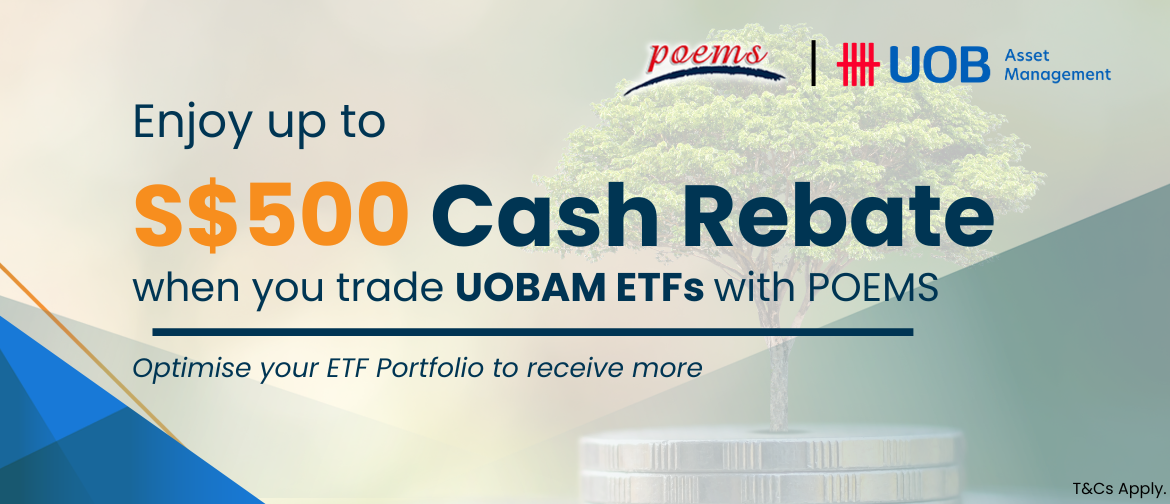SMART Park Bonus Returns
Celebrate with

Guaranteed
Return!
*Terms & Conditions Apply

Celebrating National Day with SMART Park!
For a Limited Time Only!

Guaranteed Returns
5.8% p.a.
Deposit Amount
Start from S$1,000
Earn Up to
S$238 for S$50,000 deposit
Celebrating National Day with SMART Park!
For a Limited time only!

Guaranteed
Returns
5.8 % p.a.
Deposit Amount
Start from S$1,000
Earn Up To
S$238 for S$50,000 deposit
Don't have a POEMS Account?
Don't have a POEMS Account?
Already have POEMS Account?
Fund with SMART ParkWhy SMART Park
SMART Park is an Excess Funds Management Facility that invests and manages your idle cash automatically, on a discretionary basis.Make your money work HARDER and SMARTER!No lock-in period Withdraw anytime! Cash will be back into your linked bank account on the same day! Real Return, Not Projection Rates illustrated are real returns!
Real Return, Not Projection Rates illustrated are real returns!
 Trusted with S$ 1+ Billion
One of the Largest^ retail SGD MMF, consisting of high quality, short-term instruments, including
Trusted with S$ 1+ Billion
One of the Largest^ retail SGD MMF, consisting of high quality, short-term instruments, including
- High quality government and corporate bonds
- Commercial bills and fixed deposits
Trusted Financial Institution
Serving institutions and retail investors for 50 years
- High quality government and corporate bonds
- Commercial bills and fixed deposits

Did you know?
Beyond this promotional period, you can enjoy our prevailing SMART Park rates on a long-term basis. This excess funds management facility lets you grow your idle cash during quiet periods, and gives you the flexibility to trade when you spot a potential investment opportunity!

Good Things Must Share!
Refer your Friends & Family!

Good Things Must Share!
Refer your Friends & Family!
Rewards for you
S$68
Cash Credit
Rewards for your Friends & Family!
- 5.8% p.a. Guaranteed Return
- S$20 NTUC E-Voucher
- Zero Commissions on US stocks for 1 month
(Cash Plus Account Only)
Rewards for you
S$68
Cash Credit
Rewards for your
friends & family
- 5.8% p.a. Guaranteed Return
- S$20 NTUC E-Voucher
- Zero Commission on US stocks for 1 month (Cash Plus Account only)
Find out more :
Find out more :
Invite your friends and family now!
Invite your friends and family now!
Send your personalized referral link to your friends !


Frequently Asked Questions
Which are the Account types that are eligible for the promotion?Individual Cash Plus, Cash Management, Margin, Prepaid, Custodian and UT advisory wrap accounts.
What if I am a Cash Trading or a Share Financing Account holder? Am I eligible for this promotion?No. Cash Trading and Share Financing Accounts are not eligible for this promotion. You may consider opening an eligible account type or converting your Cash Trading account to a Cash Management Account.
How do I convert my Cash Trading or Share Financing Account to Cash Management Account?Login to POEMS 2.0 Website > Acct Mgmt > Stocks > Online Forms. Cash Trading Account with existing GIRO facility has to be terminated before we can process the conversion to Cash Management Account.
I have deposited S$10,000 into my Account. Can I use my funds for investment purposes?Yes. You are allowed to use the funds to trade on POEMS. However, to be eligible for the promotion, only the net balance of deposits at the end of each day of the 30-day period will be calculated for the 5.8% p.a. returns.
Can I deposit and withdraw within a few days apart, and still be eligible for the promotion?Only the net balance of deposits at the end of day of the 30-day period will be calculated for the 5.8% p.a. returns.
Am I allowed to make multiple deposits of S$10,000? E.g. S$10,000 for the first deposit and S$15,000 for the second deposit.Yes, you can make multiple deposits. The 5.8% p.a. returns is calculated on the net balance of each day’s deposit over a 30-day period. The maximum deposit cap to enjoy the 5.8% p.a returns is S$50,000.
Can I top up more than S$50,000 to SMART Park?Yes, you can top up more than S$50,000 to SMART Park. Your deposit(s) up to S$50,000 will enjoy 5.8% p.a. returns and excess deposits will earn from SMART Park returns.
How is the 5.8% p.a bonus returns calculated? For example : Client A funded S$50,000 and held a consistent positon of S$50,000 over 30 days.He will get : S$50,000 X [(5.8%/365) X 30] = S$238.35.(Including Phillip Money Market Fund’s actual returns and PSPL’s topping up on the difference). The difference to be made up by Phillip Securities Pte Ltd (PSPL) will be calculated based on the funded amount held by a client in his account each day in 30-day period. The bonus reward (i.e. difference between 5.8% p.a. and the underlying fund return) will be credited in lump sum to your PSPL trading account as cash bonus within 30 business days after the 30-day period ends. Where do I see SMART Park rates?SMART Park Rates shown on the website are based on 7-days annualised return with net income and dividends reinvested and calculated on a single pricing basis (NAV/NAV prices). Returns shown are net of fund expenses. Past performance is not necessarily indicative of future performance.
Yes. You can continue to keep your idle cash in SMART Park to earn better returns and combat inflation.
Can I withdraw all my money?Yes. You can withdraw your money anytime. However, please note that in order to maximise your returns for the 30-day period which 5.8% p.a. is calculated, we encourage you to keep your deposits in the account to enjoy the maximum returns.
How is the 30-Day Period counted?The first day of your 30-day period begins on the same day when you make your deposit of a minimum of S$1,000 or more during the period from 1 Aug to 31 Aug 2023. Please ensure that you have opted into SMART Park (Excess Funds Management Facility) for your trading account before you make your first deposit for this promotion.
To opt in, please log in to www.poems.com.sg > Acct Mgmt > Online Forms > Excess Funds Authorization.
How do I see my returns from SMART Park?To view the returns earned: please login to www.poems.com.sg > Acct Mgmt > Stocks > Transaction History > Summary of Portfolio > MMF.
Via POEMS 2 Web :
Login > Acct Mgmt > Stocks > Transaction History > Summarty of Portfolio > MMF
Via Phillip MyWealth
Login > Home > SMART Park banner > View my Cash & Equivalents
Terms & Conditions
Terms & ConditionsCelebrate National Day with 5.8% p.a. Guaranteed Returns!
1) Promotion Period: 1 Aug 2023 (0000 hrs.) to 31 Aug 2023 (2359hrs.), both dates inclusive.
2) This promotion is open to all Phillip Securities (PSPL) Customers.
If you do not have any account with us,
New Customers :
Please open an account at https://www.poems.com.sg/open-an-account/, opt in and provide your consent to “Excess Funds Management Facility (SMART Park).
b) Unit Trust Advisory Wrap accounts :
Please approach our Phillip Investor Centres https://www.phillip.com.sg/sg/investor-centres/ or Find your Specialist https://www.phillip.com.sg/sg/talktophillip/findadviser/ to open UT advisory wrap account.
Existing Customers:
c) For trading accounts: Opt in and provide your consent to “Excess Funds Management Facility (SMART Park)”.
- Via P2 Web:
Login to www.poems.com.sg > Acct Mgmt > Online Forms > Excess Funds Authorization
- Via Phillip MyWealth Mobile App
Login > Home > SMART Park banner > Opt in or View my Cash & Equivalents
d) Fund your account:
Fund your account with S$1,000 or more (capped at S$50,000) to enjoy a 30-day return of 5.8% p.a.
You can fund your account using any of the payment methods here : https://www.poems.com.sg/payment/
3) Eligible account types:
Individual trading accounts namely, Cash Plus, Cash Management, Prepaid, Custodian, Margin accounts and UT advisory wrap accounts (cash fund source).
4) For Cash Trading account, please convert to Cash Management account if you wish to opt in to Excess Funds Management Facility.
For Account Conversion: Please login to www.poems.com.sg with your Cash Trading account login > Acc Mgmt > Online Forms > Account Conversion.
5) This promotion is for Individual account, Cash fund source and SGD deposits.
6) How are the 5.8% p.a. guaranteed returns being calculated?
For Illustration purposes:
Customer A funded S$50,000 and held a consistent position of S$50,000 over 30 days.
He will get: S$50,000 X [(5.8%/365) X 30] = S$238.36.
(Including Phillip Money Market Fund’s actual returns and PSPL’s topping up on the difference).
The difference to be made up by Phillip Securities Pte Ltd (PSPL) will be calculated based on the net funded amount held by a Customer in his account each day in the 30-day period.
The returns will be calculated based on a period of 30 days from the date of first deposit of S$1000 or more received in account.
7) The bonus reward (i.e. difference between 5.8% p.a. and the underlying fund return) will be credited in lump sum to your PSPL account within 30 business days after the 30-day period ends.
8) The deposit has to be fresh funds.
Fresh funds refer to cash transferred from the Customer’s bank account, and does not include funds transferred within PSPL accounts, cash dividends, sales proceeds or account credit transactions.
9) Only the net balance of new deposits at the end of each day in the 30-day period will be calculated for the Guaranteed 5.8% p.a. returns.
10) Any withdrawal or settlement using the deposited funds during the 30-day period will be excluded from our calculations.
11) The first day of your 30-day period begins when your deposit of S$1,000 or more (fresh funds) is credited in your account during the period from 1 Aug to 31 Aug 2023. Please ensure that you have opted into SMART Park (Excess Funds Management Facility) for your trading account before you make your first deposit for this promotion.
12) The bonus reward (i.e. difference between 5.8% p.a. and the underlying fund return) will be paid out in SGD.
13) All fresh funds have to be deposited by 31 Aug 2023 to be eligible for this promotion.
14) For clients who withdraw from their existing Phillip accounts and deposit funds again in their accounts during the Promotion Period, only the Net New Deposit Amount (new deposits less withdrawals during the Promotion Period) will be considered for the Promotion.
15) The Customer must be at least 18 years of age and not a US Person (an individual who is a US Citizen or US resident).
16) Each Customer is only eligible for one bonus reward in one of the accounts.
17) If a Customer has more than 1 PSPL accounts, the account first funded with S$1,000 or more (1 lump sum) will be considered to be eligible for the bonus reward.
18) In the event of a dispute over the Customer’s eligibility to participate in this promotion, PSPL’s decision will be final.
19) Notwithstanding anything herein contained, PSPL reserves the right at any time in its absolute discretion to (i) amend, add and/or delete these Terms and Conditions without prior notification (including eligibility; replacement of the reward; promotional mechanics, promotion duration without prior notification, qualifying terms and criteria), and all participants shall be bound by such amendments, additions and / or deletions when effected, or (ii) vary, withdraw, or cancel any items or the promotion without having to disclose a reason thereof and without any compensation or payment whatsoever. PSPL’s decision on all matters relating to the promotion shall be final and binding on all participants.
20) The following persons are not eligible to participate in those promotions unless approved by the management of Phillip Securities Pte Ltd (“PSPL”):
i) PSPL institutional Customers and corporate Customers
ii) PSPL Account holders whose Accounts have been suspended, cancelled or terminated
iii) Joint Accounts
iv) Customers who engage the services of a representative from an external provider (B2B)
21) By taking part in this campaign, the participant acknowledges that he / she has read and consented to these Terms & Conditions.
22) This advertisement has not been reviewed by the Monetary Authority of Singapore.
23) By Submitting the form you give consent to use your personel data, as mentioned on the following url: https://www.poems.com.sg/consent-to-use-of-your-personal-data/
POEMS mid autumn giveaway 2023

POEMS wishes you happiness, a joyful family reunion and a happy Mid-Autumn Festival!
In celebration of the coming Mid-Autumn Festival, POEMS is giving away:
5 x Golden Village e-Movie vouchers (Yes! You can share them with your friends)
There will be a total of 6 lucky winners!
How to participate
- 1. 1.Follow both IG accounts @investingwithphillipcapital 以及 @phillipcapital
- 2.Like & share this post and Tag 5 friends who enjoy movies
- 3.Comment on this giveaway post:

(i) The answer to the question in the post (select one answer) and
(ii) Tell us: What do you like most about the Mid-Autumn Festival?
*Multiple entries are allowed
6 winners with the best answers will be selected.。
The giveaway ends on 29 September 2023, 23:59 SGT.
Winners will be announced on 9 October 2023, 18:00 SGT and notified via Instagram Direct Message. Instructions on prizes will be given within 3-5 Business days after the campaign period has ended.
FAQ
Is this Giveaway exclusively for POEMS Account holders?No, you don’t need to be a POEMS Account holder. All are welcome to participate.
How do I participate in this Giveaway?1.Follow the PhillipCapital Instagram accounts (@phillipcapital and @investingwithphillipcapital)
2.Like & share this post and tag five friends (Instagram accounts) in the aforementioned post.
3.Comment on the giveaway post –the answer to the question (select one answer) and tell us “What do you like most about the Mid-Autumn Festival?”
Terms and Conditions for Mid-Autumn giveaway 2023
- To participate in this Instagram giveaway, participants are required to perform all of the following actions within 7 September 2023 1200 hours (SGT) to 29 September 2023 2359 hours (SGT) (hereafter referred to as the ‘Campaign Period’)
- Follow the PhillipCapital Instagram accounts:
- @phillipcapital
- @investingwithphillipcapital
Like & share this post and tag five friends (Instagram accounts) in the aforementioned post.
Comment on the giveaway post – answer the question in the post and tell us “What do you like most about the Mid-Autumn Festival?”
- Follow the PhillipCapital Instagram accounts:
- 6 best answers will be chosen by our panel of judges.
- Prizes::5 x Golden Village e-Movie vouchers
- Entries submitted after the campaign period will not be accepted. Phillip Securities Pte Ltd (PSPL) reserves all rights to disqualify any incomplete submissions or submissions that do not abide Instagram guidelines.
- Winners will be announced on the PhillipCapital Instagram (@phillipcapital) and @investingwithphillipcapital page on 9 October 2023.
- Winners will be contacted 3-5 business days after the announcement has been made (9 October 2023), by Instagram Direct Message for more details on prize redemption.
- The following persons are not eligible for this promotion, unless approved by the management of Phillip Securities Pte Ltd (“PSPL”):
- PSPL institutional Customers and corporate Customers
- PSPL Account holders whose Accounts have been suspended, cancelled or terminated
- PSPL and its associated entities and subsidiaries (direct or indirect), e.g. Staff, Trading Representatives and Financial Adviser Representatives.
- Prizes are non-exchangeable for cash or other items. All images of the prize(s) and all collaterals are for illustration purposes only. Should the prizes be unavailable for any reason, PSPL, in its discretion, reserves the right to substitute the original prize with an alternative prize with a similar monetary value.
- Should the winner be uncontactable by 31 October 2023, his/her prize will be forfeited. PSPL reserves the right to decide on one (1) or more reserve winner to replace the disqualified winner. PSPL has the absolute discretion to exclude any otherwise eligible persons from participating in the Giveaway.
- Participants of this Giveaway are bound by the promotional guidelines of Instagram: https://www.facebook.com/help/instagram/179379842258600 and exempts PSPL from any liability arising from any act, omission or default in connection with the use and operation of the operating platforms for Instagram over which PSPL has no control over. This Giveaway is in no way sponsored, endorsed or administered by, or associated with Instagram. The information collected from this Giveaway will belong solely to PSPL.
- In the event of a dispute over the Customer’s eligibility to participate in this Giveaway, PSPL’s decision will be final.
- PSPL reserves the sole right to refuse to award the aforementioned prizes without any prior notice to any participants for any reasons, particularly when participants have behaved inappropriately, whether through posting inappropriate remarks or through unconventional means or otherwise.
- PSPL reserves the right at any time in its absolute discretion to (i) amend, add and / or delete any of these Terms and Conditions without prior notification (including eligibility and qualifying terms and criteria), and all participants shall be bound by such amendments, additions and / or deletions when effected, or (ii) vary, withdraw, or cancel any items of the Giveaway without having to disclose a reason thereof and without any compensation or payment whatsoever. The decision of PSPL on all matters relating to the Giveaway shall be final and binding on all participants.
- By entering the Giveaway, participants agree and consent to allow PSPL to use their Instagram ID, photograph, or likeness in all matters related to this Giveaway including any advertising or publicity without additional compensation or notification.
- By taking part in this Giveaway, participants acknowledge that he/she has read and consented to these Terms and Conditions.
Campaign
ZERO Commission on US Stocks – INVEST Fair 2023

Exclusively for INVEST Fair 2023 ZERO* COMMISSION ON US STOCKS
Why Choose POEMS Cash Plus Account?

ZERO Platform Fee

Multi-currency facility
Settle trades with 10 different currencies – SGD, USD, HKD, AUD, MYR, JPY, GBP, EUR, CNY, CAD

ZERO Custody Fee

Complimentary live prices
For US, Thailand, Malaysia, & Indonesia

ZERO Settlement Fee

Financing available in 9 Currencies
SGD, USD, HKD, JPY, AUD, GBP, EUR, CNY & CAD

ZERO Platform Fee

ZERO Custody Fee

ZERO Settlement Fee

Multi-currency facility
Settle trades with 10 different currencies – SGD, USD, HKD, AUD, MYR, JPY, GBP, EUR, CNY, CAD

Complimentary live prices
For US, Thailand, Malaysia, & Indonesia

Financing available in 9 Currencies
SGD, USD, HKD, JPY, AUD, GBP, EUR, CNY & CAD
NO HIDDEN FEE
Open POEMS Cash Plus Account NowNO HIDDEN FEES
Open POEMS Cash Plus Account NowTerms & Conditions
Terms & Conditions- Promotion period:
- This promotion is valid from 14 August 2023 to 31 December 2023 (both dates inclusive).
- Qualifying Criteria:
- This promotion is only valid and exclusive for those who visited the PhillipCapital booth during INVEST Fair 2023 on 12 August 2023 and/or 13 August 2023.
- This promotion is only applicable to new Cash Plus Accounts.
- This promotion is only applicable to all Phillip Securities Pte Ltd (“PSPL”) Customers who have not opened a POEMS Account, based on the Client’s unique NRIC/FIN number.
- Each Customer is entitled to ONE reward per NRIC/FIN number.
- Reward:
- Zero commission for US Stocks.
- Redemption:
- Eligible Customers who
- visit the PhillipCapital booth (A2) during the INVEST Fair 2023 and open a POEMS Cash Plus Account to enjoy the Zero Commission promotion OR
- wish to open a POEMS Cash Plus Account at any of our Phillip Investor Centres between 14 August 2023 to 19 August 2023. They are required to bring along the namecard of a the PhillipCapital advisory representative / staff with the Phillip Securities stamp.
- Eligible Customers who
- The following persons are not eligible to participate in this promotion unless approved by the management of PSPL:
- PSPL existing Account holders who did not open Accounts at INVEST Fair 2023.
- PSPL Institutional Customers and Corporate Customers.
- PSPL Joint Accounts
- PSPL Account holders whose Accounts have been suspended, canceled or terminated.
- PSPL and its associated entities and subsidiaries (direct or indirect), e.g. Staff, Trading Representatives and Financial Adviser Representatives, including their spouse and direct family members.
- PSPL reserves the right at any time in its absolute discretion to (i) amend, add to, and/or delete at any time of these Terms & Conditions without prior notice (including eligibility and qualifying terms and criteria), and all Customers shall be bound by such amendments, additions and/or deletions when effected, or to (ii) vary, withdraw, and/or cancel any items or the promotion itself without having to disclose a reason, and without any compensation or payment whatsoever. PSPL’s decisions on all matters relating to the promotion are final and binding on all Customers.
- PSPL and its affiliates and their respective employees and agents shall not be liable to any person for any loss, damage, injury, costs or expenses incurred, suffered, borne or arising from this promotion.
- By redeeming this item, you acknowledge that you have read and consented to these Terms and Conditions.
Mobile Capture- smart cap


Request a Call Back
Submit your contact details, our customer support executive will reach you as soon as possible. (Customer support work timing - Weekdays: 9 am to 5 pm SGT)
Request a Call Back
Submit your contact details, our customer support executive will reach you as soon as possible. (Customer support work timing - Weekdays: 9 am to 5 pm SGT)
Copyright © 2023. Brought to you by Phillip Securities Pte Ltd (A member of PhillipCapital) Co. Reg. No. 197501035Z. All Rights Reserved.
This advertisement has not been reviewed by the Monetary Authority of Singapore.
Disclaimer Privacy & Security Risk Disclosure Terms & Conditions Guide & Cautionary Note Best Execution Policy Security Advisory
SDR Promo Aug 2023
 Zero Brokerage with Singapore Depository Receipts (SDR) from
7 August to 25 October 2023
Zero Brokerage with Singapore Depositary Receipts (SDR) from
7 August to 25 October 2023
Zero Brokerage with Singapore Depository Receipts (SDR) from
7 August to 25 October 2023
Zero Brokerage with Singapore Depositary Receipts (SDR) from
7 August to 25 October 2023
 AOT Airports of Thailand
Trade
AOT Airports of Thailand
Trade
 CP ALL
Trade
CP ALL
Trade
 PTT Exploration and Production
Trade
Don’t have an Account?
Open An Account Now
Alternatively, visit any of our Phillip Investor Centres or contact your trading representives.
Terms & Conditions
Terms and Conditions
PTT Exploration and Production
Trade
Don’t have an Account?
Open An Account Now
Alternatively, visit any of our Phillip Investor Centres or contact your trading representives.
Terms & Conditions
Terms and Conditions
- This promotion offers a commission rebate to trade Singapore Depository Receipt (“SDR”) with 0 brokerage from 7 August to 25 October 2023.
- SDR trades must be executed on our suites of the POEMS platform.
- Customers will be required to pay the prevailing SGX clearing fee, SGX access fee and other related fees, and the associated GST.
- Eligible Accounts used for trading of SDRs must be Cash Plus, Margin (M), Custodian (C), Prepaid Custodian (CC), Cash Management (KC) and Share Financing (V) Accounts.
- Each Customer can only claim the rebate once. Customer(s) with multiple Accounts will not qualify for the rebate again.
- The rebate will be paid to your Trading Account in October 2023.
- The following persons are not eligible to participate in those promotions unless approved by the management of Phillip Securities Pte Ltd (“PSPL”): a. PSPL institutional Customers and Corporate Customers b. PSPL Account holders whose Accounts have been suspended, canceled or terminated. c. PSPL and its associated entities and subsidiaries (direct or indirect), e.g. Staff, Trading Representatives and Financial Adviser Representatives including their spouse and direct family members.
- Notwithstanding anything herein contained, PSPL reserves the right at any time in its absolute discretion to (i) amend, add and/or delete any time of these Terms & Conditions without prior notification (including eligibility and qualifying terms and criteria), and all participants shall be bound by such amendments, additions and/or deletions when effected, or (ii) vary, withdraw, or cancel any items or the promotion without having to disclose a reason thereof and without any compensation or payment whatsoever. PSPL’s decision on all matters relating to the promotion shall be final and binding on all participants.
- In the event of a dispute over the client’s eligibility to participate in this Promotion, PSPL’s decision will be final. PSPL shall not be obliged to give any reason on any matter concerning the Promotion and no correspondence or claims will be entertained.
- By taking part in this promotion, the customer acknowledges that he/she has read and consented to these Terms & Conditions.
 Don’t miss this opportunity!!
Trade Now
Open an Account
Don’t miss this opportunity!!
Trade Now
Open an Account
 Don’t miss this opportunity!!
Trade Now
Open an Account
For more about Singapore Depository Receipts (SDR), you might refer to here.
Don’t miss this opportunity!!
Trade Now
Open an Account
For more about Singapore Depository Receipts (SDR), you might refer to here.SMART Park Bonus Returns
 Guaranteed
Return!
*Terms & Conditions Apply
Guaranteed
Return!
*Terms & Conditions Apply

Celebrating National Day with SMART Park!
Deposit within August 2023 for a 30-day Period!
 Guaranteed Returns
5.8% p.a.
Deposit Amount
Start from S$1,000
Earn Up to
S$238 for S$50,000 deposit
Guaranteed Returns
5.8% p.a.
Deposit Amount
Start from S$1,000
Earn Up to
S$238 for S$50,000 deposit
Celebrating National Day with SMART Park!
Deposit within August 2023 for a 30-day Period!
 Guaranteed
Returns
5.8 % p.a.
Deposit Amount
Start from S$1,000
Earn Up To
S$238 for S$50,000 deposit
Don't have a POEMS Account?
Don't have a POEMS Account?
Already have POEMS Account?
Fund with SMART Park
Guaranteed
Returns
5.8 % p.a.
Deposit Amount
Start from S$1,000
Earn Up To
S$238 for S$50,000 deposit
Don't have a POEMS Account?
Don't have a POEMS Account?
Already have POEMS Account?
Fund with SMART Park
Why SMART Park
SMART Park is an Excess Funds Management Facility that invests and manages your idle cash automatically, on a discretionary basis.Make your money work HARDER and SMARTER!No lock-in period Withdraw anytime! Cash will be back into your linked bank account on the same day! Real Return, Not Projection Rates illustrated are real returns!
Real Return, Not Projection Rates illustrated are real returns!
 Trusted with S$ 1+ Billion
One of the Largest^ retail SGD MMF, consisting of high quality, short-term instruments, including
Trusted with S$ 1+ Billion
One of the Largest^ retail SGD MMF, consisting of high quality, short-term instruments, including
- High quality government and corporate bonds
- Commercial bills and fixed deposits

Did you know?
Beyond this promotional period, you can enjoy our prevailing SMART Park rates on a long-term basis. This excess funds management facility lets you grow your idle cash during quiet periods, and gives you the flexibility to trade when you spot a potential investment opportunity! Learn More >> Good Things Must Share!
Refer your Friends & Family!
Good Things Must Share!
Refer your Friends & Family!
 Good Things Must Share!
Refer your Friends & Family!
Rewards for you
S$68
Cash Credit
Rewards for your Friends & Family!
Good Things Must Share!
Refer your Friends & Family!
Rewards for you
S$68
Cash Credit
Rewards for your Friends & Family!
- 5.8% p.a. Guaranteed Return
- S$20 NTUC E-Voucher
- Zero Commissions on US stocks for 1 month (Cash Plus Account Only)
- 5.8% p.a. Guaranteed Return
- S$20 NTUC E-Voucher
- Zero Commission on US stocks for 1 month (Cash Plus Account only)


Frequently Asked Questions
Which are the Account types that are eligible for the promotion? Individual Cash Plus, Cash Management, Margin, Prepaid, Custodian and UT advisory wrap accounts. What if I am a Cash Trading or a Share Financing Account holder? Am I eligible for this promotion? No. Cash Trading and Share Financing Accounts are not eligible for this promotion. You may consider opening an eligible account type or converting your Cash Trading account to a Cash Management Account. How do I convert my Cash Trading or Share Financing Account to Cash Management Account? Login to POEMS 2.0 Website > Acct Mgmt > Stocks > Online Forms. Cash Trading Account with existing GIRO facility has to be terminated before we can process the conversion to Cash Management Account. I have deposited S$10,000 into my Account. Can I use my funds for investment purposes? Yes. You are allowed to use the funds to trade on POEMS. However, to be eligible for the promotion, only the net balance of deposits at the end of each day of the 30-day period will be calculated for the 5.8% p.a. returns. Can I deposit and withdraw within a few days apart, and still be eligible for the promotion? Only the net balance of deposits at the end of day of the 30-day period will be calculated for the 5.8% p.a. returns. Am I allowed to make multiple deposits of S$10,000? E.g. S$10,000 for the first deposit and S$15,000 for the second deposit. Yes, you can make multiple deposits. The 5.8% p.a. returns is calculated on the net balance of each day’s deposit over a 30-day period. The maximum deposit cap to enjoy the 5.8% p.a returns is S$50,000. Can I top up more than S$50,000 to SMART Park? Yes, you can top up more than S$50,000 to SMART Park. Your deposit(s) up to S$50,000 will enjoy 5.8% p.a. returns and excess deposits will earn from SMART Park returns. How is the 5.8% p.a bonus returns calculated? For example : Client A funded S$50,000 and held a consistent positon of S$50,000 over 30 days.He will get : S$50,000 X [(5.8%/365) X 30] = S$238.35.(Including Phillip Money Market Fund’s actual returns and PSPL’s topping up on the difference). The difference to be made up by Phillip Securities Pte Ltd (PSPL) will be calculated based on the funded amount held by a client in his account each day in 30-day period. The bonus reward (i.e. difference between 5.8% p.a. and the underlying fund return) will be credited in lump sum to your PSPL trading account as cash bonus within 30 business days after the 30-day period ends. Where do I see SMART Park rates? SMART Park Rates shown on the website are based on 7-days annualised return with net income and dividends reinvested and calculated on a single pricing basis (NAV/NAV prices). Returns shown are net of fund expenses. Past performance is not necessarily indicative of future performance.Terms & Conditions
Terms & Conditions Celebrate National Day with 5.8% p.a. Guaranteed Returns! 1) Promotion Period: 1 Aug 2023 (0000 hrs.) to 31 Aug 2023 (2359hrs.), both dates inclusive. 2) This promotion is open to all Phillip Securities (PSPL) Customers. If you do not have any account with us, New Customers : a) Trading accounts : Please open an account at https://www.poems.com.sg/open-an-account/, opt in and provide your consent to “Excess Funds Management Facility (SMART Park). b) Unit Trust Advisory Wrap accounts : Please approach our Phillip Investor Centres https://www.phillip.com.sg/sg/investor-centres/ or Find your Specialist https://www.phillip.com.sg/sg/talktophillip/findadviser/ to open UT advisory wrap account. Existing Customers: c) For trading accounts: Opt in and provide your consent to “Excess Funds Management Facility (SMART Park)”.- Via P2 Web:
- Via Phillip MyWealth Mobile App
24 Hours US Trading Symposium

About Towards 24 Hours US Trading Symposium
Intrigued in using our latest special feature on POEMS platforms in trading the US Market during the Asian Hours but unsure how to make good use of it?
Now here is your chance! Tune in our Towards 24 hours US Trading Symposium webinar on 5 July 2023, Wednesday, from 12pm to 2pm on Zoom to understand more about our US Asian Hours trading feature and the strategies to tackle it!
What's even better in store? You will also get to listen to the main key person, Hitoshi Shimoyama, who started this unique feature project in this webinar!
So what are you waiting for? Register with us now!
SAVE THE DATE
- 5 July 2023, Wednesday
- 12:00pm to 2:00pm
- Zoom Webinar
Programme Outline
12:15pm to 12:30pm
Opening Address & Keynote Speech – POEMS

Luke Lim, Managing Director
As the Managing Director of Phillip Securities Pte Ltd (PSPL), Luke oversees PSPL’s daily operational businesses, strategic directions and executes management decisions for performance-driven results in consultation with the board of directors. He honed his management leadership style having been responsible for various roles in the PhillipCapital Group of companies since 2004. His experience covers research solutions, overall strategy and business development.
12:30pm to 1:30pm
Sharing of Trading ideas using POEMS towards 24 Hours US Trading
1) US Stocks Picks by Paul Chew
- Insights and recommendations for key IT stocks namely Amazon, Salesforce and many others!
2) New Opportunities towards 24 Hours US Trading by Lawrence Lee
- How to make use of trends and news to trade US Asian Hours, ahead of the US opening.
3) Trade with Volatility towards 24 hours US Trading by Hitoshi Shimoyama
- How to seek for opportunities in trading uptrend, sideway, or downtrend markets with QQQ.
4) Trade US American Depositary Receipts (ADRs) in US Asian Hours: All the things you should know by Jason Fu
- Investors can now trade US ADRs such as Alibaba and Baidu round the clock with US Asian Hours from 9am (SG time). How can you “up” the game by making use of the news flow in Asian hours and trade into these US ADRs? The speaker will share on the link between the US ADRs and its domestic market trading activities.
Our Speakers:

Hitoshi Shimoyama, Executive Director
Hitoshi Shimoyama has more than 40 years of experience in the financial industry. He ran Phillip Securities Japan as the CEO for 11 years and currently serving as the executive director of Phillip Securities Singapore. He is the project manager who started the idea of US Asian Hours, which is the first launch in Singapore, and 24 hours US trading. He graduated from University of Tokyo.

Paul Chew, Head of Phillip Securities Research
Paul has 20 years of experience as a fund manager and sell-side analyst. During his time as fund manager, he has managed multiple funds and mandates including capital guaranteed, dividend income, renewable energy, single country and regionally focused funds.

Lawrence Lee, Head of Corporate Development
Lawrence has more than 13 years of experience in the stockbroking industry with in-depth knowledge of Dealing, Sales and Business Development. He ran the Business for Business Department which service Corporate and institutional customers. He passed his CFA Level 3 Examination in 2016 and graduated from Royal Melbourne Institute of Technology with a Bachelor of Business in Economic and Finance.

Jason Fu, Deputy Head of Global Markets
Jason has more than 17 years of experience in the stockbroking industry with in-depth knowledge in dealing, sales and product development. He previously ran the Global Markets sales team which services retail, high net worth, corporate as well as B4B customers. He also heads the ETF team where they work with global ETF issuers and exchanges to raise the profile of ETFs as an investment product. He graduated from Singapore Institute of Management (SIM) with a Bachelor of Science in Finance.
1:30pm to 2pm
Q&A Session
Interested in the event?
Register NowFrequently Asked Questions
Do I need a Zoom Account to join this webinar?You do not need a Zoom account to join the webinar. Please click on the link in the confirmation email and join the session via Zoom Web Client (works best on Chrome) or download Zoom on desktop or mobile before the session starts.
Will I receive a reminder to join the webinar?You will receive an email reminders 1 day, and 1 hour prior to the webinar. Do check your email for the link to join.
Will the webinar be recorded?Yes. The webinar will be recorded and will be uploaded on PhillipCapital YouTube Channel.
How does Q&A work?We are using the up-vote system where Q&A will start from questions with the highest number of votes. Due to time constraint, similar questions will only be answered once. Also, speakers will only answer questions specific to the presenting market. We will clear off all the questions after each session so as not to confuse the next speaker.
POEMS UOBAM ETF PROMO

Limited Time Only! From 1 June 2023 - 31 July 2023
How to Qualify for this Promotion?
 Fulfil a minimum of S$10,000 Gross Traded Value for Buy trades in total for any of these 3 selected ETFs:
Fulfil a minimum of S$10,000 Gross Traded Value for Buy trades in total for any of these 3 selected ETFs:
UOBAM PingAn Chinext ETF
(SGD: CXS, USD: CXU)UOB APAC Green REIT ETF
(SGD: GRN, USD: GRE)United SSE 50 China ETF
(JK8)
 Ensure that your trades are done from 1 June 2023 to 31 July 2023 with a minimum one month holding period.
Ensure that your trades are done from 1 June 2023 to 31 July 2023 with a minimum one month holding period.
 Fulfil a minimum of S$10,000 Gross Traded Value for Buy trades in total for any of these 3 selected ETFs:
Fulfil a minimum of S$10,000 Gross Traded Value for Buy trades in total for any of these 3 selected ETFs:
UOBAM PingAn Chinext ETF (SGD: CXS, USD: CXU)
UOB APAC Green REIT ETF (SGD: GRN, USD: GRE)
United SSE 50 China ETF (JK8)
 Ensure that your trades are done from 1 June 2023 to 31 July 2023 with a minimum one month holding period.
Ensure that your trades are done from 1 June 2023 to 31 July 2023 with a minimum one month holding period.
For more information refer to Terms and Conditions below.
Why invest in UOB AM PingAn Chinext ETF? (SGD: CXS, USD: CXU)Take advantage of the growth prospects presented by China's 14th five-year plan, which aims to enhance the sustainability of economic expansion and improve the standard of living for its populace. Why invest in UOB AM APAC Green REIT ETF? (SGD: GRN, USD: GRE)The fund has the potential to provide both profit and capital appreciation. It strives to promote real estate operational and management methodologies targeted at reducing carbon and other greenhouse gas emissions. The index picks and includes 50 REITs with higher yields that are listed in the region and exhibit comparatively superior environmental performance as determined by GRESB's real estate evaluation. Additionally, they meet the minimum liquidity criteria.Why invest in United SSE 50 China ETF? (JK8)The SSE 50 index is composed of the 50 most sizable and liquid stocks listed on the SSE, and is widely acknowledged and cited as a gauge of the China A-Shares market. Its objective is to mirror the performance of prominent, high-quality, and impactful large firms operating on the SSE. Previous slide Next slide Sources:- https://www.uobam.com.sg/our-funds/highlights/uobam-ping-an-chinext-etf/index.page
- https://www.uobam.com.sg/sustainability/solutions/uob-apac-green-reit-etf.page#whyinvest
- https://www.uobam.com.sg/china-etf/index.page
What's even better?
Achieve the Highest Gross traded value for Buy trade to receive the
Ultimate Grand Prize - S$500 Cash Rebate
![]()
![]()
![]()
![]()
T&Cs Apply.

Use this Opportunity to build your ETF Portfolio!
Trade UOBAM PingAn Chinext ETF (SGD: CXS) Trade UOBAM PingAn Chinext ETF (USD: CXU) Trade UOB APAC Green REIT ETF (SGD: GRN) Trade UOB APAC Green REIT ETF (USD: GRE) Trade United SSE 50 China ETF (JK8) Trade UOBAM PingAn Chinext ETF (SGD: CXS) Trade UOBAM PingAn Chinext ETF (USD: CXU) Trade UOB APAC Green REIT ETF (SGD: GRN) Trade UOB APAC Green REIT ETF (USD: GRE) Trade United SSE 50 China ETF (JK8)Frequently Asked Questions
Which Account types are eligible for this promotion?Cash Plus, Cash Management, Margin, Prepaid, Custodian, and Share Financing Accounts.
What if I am a Cash Trading Account holder? Am I eligible for this promotion?No. Cash Trading Accounts are not eligible for this promotion. You may consider opening an eligible account type or converting your Cash Trading account to a Cash Management Account.
How do I convert my Cash Trading to Cash Management Account?Login to POEMS 2.0 Website > Acct Mgmt > Stocks > Online Forms. Cash Trading Account with existing GIRO facility has to be terminated before we are able to process the conversion of your existing Cash Trading to a Cash Management Account.
I have a combined gross traded value for buy trades of S$10,000 across the three selected ETFs during the campaign period (1 June 2023 to 31 July 2023). Is it guaranteed that I will receive a cash rebate of S$20?No, the consolation prize of S$20 will be awarded to the 50 clients who gather the highest gross traded value for buy trades within 2 months from the start of the campaign period, 1 June 2023.
Will I still be eligible for the cash rebate if I meet the S$10,000 minimum gross traded value for buy trade eligibility criteria, but have sold away the ETF shares before the 1-month holding period?Customers who do not meet the 1-month holding period will automatically be withdrawn from the campaign.
Will I be qualified for the campaign if I purchase S$3000 of UOB AM PingAn Chinext ETF and S$8000 of UOB APAC Green REIT ETF?Yes, the minimum S$10,000 gross traded value for buy trades can be combined across any of the 3 selected ETFs.
In this instance, it will be S$3000 + S$8000. Assuming that you fulfil the minimum holding period, you will be qualified for the campaign. Consolation prize of S$20 cash rebate will be awarded to the 50 clients who gather the highest gross traded value for buy trades (excluding the top 3 highest), within 2 months from the start of the campaign, 1 June 2023.
Will I be automatically qualified for the 1st, 2nd or 3rd prize if my gross traded value for buy trade is S$50,000?The winners for the 1st, 2nd, or 3rd prize will be selected based on the highest gross traded value for buy trades across the eligible pool of customers respectively.
When will I receive the rebate?The rebates will be disbursed to the Customers’ eligible Accounts by end of September 2023.
Terms and Conditions
Terms and Conditions
- This promotion period is valid from 1 June 2023 to 31 July 2023, both dates inclusive.
- Qualifying account types for this promotion:
- Cash Plus
- Cash Management
- Margin
- Prepaid
- Custodian
- Share Financing
- Qualifying criteria to be eligible for the Cash Rebate Prizes:
- Customers will need to execute online Buy trades traded through POEMS Trading Platforms (POEMS 2.0, POEMS Mobile 2.0, POEMS Mobile 3, and POEMS Pro) for the three selected ETFs listed below:
- Eligible types of Buy trades:
- SRS
- Cash
- Customers will need to fulfill the minimum gross traded value for buy trades of S$10,000 within two months from the start of the promotion (promotion period: 1 June 2023 to 31 July 2023) with a minimum of 1-month holding period.
- The minimum S$10,000 gross traded value for buy trades per Customer can be combined across the selected three ETFs.
- The Cash Rebates Prizes will be given to the top 53 Customers (top 3 and 50) with the highest gross traded value for buy trades within 2 months from the start of the promotion, 1 June 2023, and will be awarded accordingly to their gross traded value for buy trades:
- 1st Prize: S$500 Cash Rebate
- 2nd Prize: S$300 Cash Rebate
- 3rd Prize: S$200 Cash Rebate
- Consolation Prize (50 winners): S$20 Cash Rebate
- Each Customer is only eligible to receive one-time cash rebate throughout the whole campaign.
- Notification of the Prizes:
- The winners will be announced through email notification in September 2023.
- The Cash Rebate will only be credited to the eligible Customers’ POEMS Accounts after the one month holding period.
- In the event of a dispute over the Customer’s eligibility to participate in this promotion, PSPL’s decision is final.
- Notwithstanding anything herein contained, PSPL reserves the right at any time in its absolute discretion to amend, add and/or delete these Terms and Conditions without prior notification (including eligibility; replacement of the reward; promotional mechanics, promotion duration without prior notification, qualifying terms and criteria), and all participants shall be bound by such amendments, additions and / or deletions when effected, or vary, withdraw, or cancel any items or the promotion without having to disclose a reason thereof and without any compensation or payment whatsoever. PSPL’s decision on all matters relating to the promotion shall be final and binding on all participants.
- The following persons are not eligible to participate in those promotions unless approved by the management of Phillip Securities Pte Ltd (“PSPL”):
- Cash Trading Account holders
- PSPL institutional Customers and corporate Customers.
- PSPL Account holders whose Accounts have been suspended, canceled or terminate
- All employees of PSPL and its associated entities; PSPL and all its subsidiaries.
- Joint Account holders.
- By taking part in this campaign, the participant acknowledges that he / she has read and consented to these Terms & Conditions.
- This advertisement has not been reviewed by the Monetary Authority of Singapore.
LIMITED TIME ONLY
Optimise your ETF Portfolio to receive more!
Open a POEMS AccountCommunity Chest Donation Voucher

Use your POEMS Reward Points to donate for a better cause with Community Chest
What is a Community Chest Donation Voucher?
Community Chest Donation Voucher
The Change for Charity programme by Community Chest, the philanthropy and engagement arm of the National Council of Social Service, invites everyone to seamlessly weave giving into their daily routines. Community Chest has partnered with forward-thinking businesses to integrate giving into your everyday transactions.
All donations raised goes towards supporting over 50 critical programmes across 2 causes:


For more information about Change for Charity, visit www.comchest.gov.sg/changeforcharity.
Where appropriate, Community Chest may share necessary data with other Government agencies, so as to improve the discharge of public functions, and to serve you in the most efficient and effective way unless such sharing is prohibited by law. Please write to ncss_comchest@ncss.gov.sg for any queries.
How to Donate?
- Login to POEMS 2.0 Web > Head to Markets & Data Rewards tab.
- Navigate to the S$50 ComChest Donation Voucher under the “Voucher” section.
- Tick the checkbox to redeem S$50 ComChest Donation Voucher using your 2,500 POEMS Reward Points respectively, and click the “Submit” button.
S$50 ComChest Donation Voucher can be redeemed with 2,500 POEMS Reward Points
Redeem NowFrequently Asked Questions
Why am I not able to redeem Community Chest Donation vouchers?
This can happen for one of two reasons:
- Each Customer may only redeem 1 x S$50 Community Chest Donation per month. You may have hit the maximum redemption value for the month.
- You have insufficient POEMS Reward Points for redemption.
The confirmation email will be sent to the email address registered to your POEMS Account within 5 working days from the date of redemption. If you have yet to receive the voucher after 5 working days, kindly check your junk or spam folder.
IMPORTANT: Please ensure that the email address registered to your POEMS Account is accurate.
Is the donation entitled for tax deduction submission?Yes, the donation voucher is tax deductible. Please note that you can enjoy a tax deduction on the total amount you have redeemed for donation, not the matching amount by the government or PSPL.
What is the process for tax deduction submission?No action is required. NCSS will submit your personal information and donation amount to IRAS at the following tax assessment year on your behalf.
How do I know if the donation amount is being submitted to IRAS?Your donation amount will be reflected in your following years’ tax statement. Should there be any dispute about the donation amount, please contact NCSS at ncss_comchest@ncss.gov.sg for clarification. Please keep the donation voucher redemption email confirmation for record purpose.
Terms and Conditions
Terms and Conditions- This donation campaign is valid from 1 April 2025 to 31 March 2026.
- Each Customer holding a Cash Plus, Cash Management, Cash Trading, Margin, Prepaid, Custodian or Share Financing Account may redeem S$50 worth of Community Chest Donation voucher per month.
- The voucher, once redeemed, will be donated to the Community Chest Fund new initiative – Change for Charity Fund.
- The voucher is not refundable or exchangeable for cash.
- The voucher redemption confirmation will be sent to the Customer’s registered email address (registered to the Customer’s POEMS Account) within 5 working days from the date of redemption.
- Phillip Securities Pte Ltd (PSPL) reserves the right to change the terms and conditions at any point of time.
- In case of dispute, the decision of PSPL shall be final.
- PSPL, its affiliates and their respective employees and agents shall not be liable to any person for any loss, damage, injury, costs or expenses incurred, suffered, borne or arising from this promotion.
- By redeeming this item, you agree to share your personal information (Name, ID, email address) with our third-party community service provider, National Council of Social Service, for the purpose of submitting your donation for tax deduction and conducting surveys or promoting initiatives to you.
- Where appropriate, Community Chest may share necessary data with other Government agencies, so as to improve the discharge of public functions, and to serve you in the most efficient and effective way unless such sharing is prohibited by law. Please refer to www.comchest.gov.sg/privacy for further details and write to ncss_comchest@ncss.gov.sg for any queries.
- By redeeming this item, you acknowledge that you have read and consented to these Terms and Conditions.

